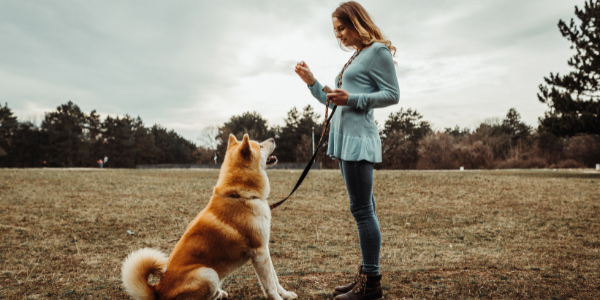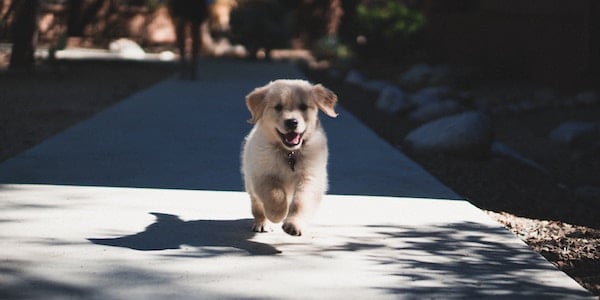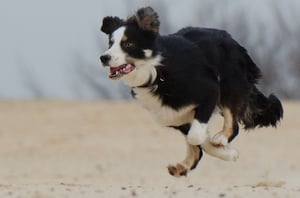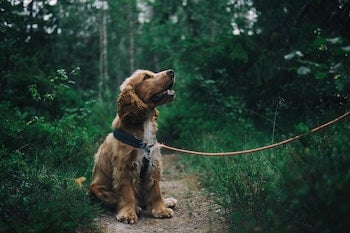 One of the ultimate goals in training your dog is being able to trust that they will do as asked without needing a food treat reward every time.
One of the ultimate goals in training your dog is being able to trust that they will do as asked without needing a food treat reward every time.
What dog owner wants to walk around with a pocketful of turkey everywhere they go, every day, for the rest of their dog's life? That's certainly not very realistic! Thankfully, it's also not necessary.
Dog treats are important and useful when first introducing a new behavior to your dog, and are an integral part of positive reinforcement training. We wouldn’t show up to work every day if we didn’t get a paycheck, and treats are a high-value currency to our dogs.
Dogs deserve to get paid for their work. Unfortunately, one of the main reasons dog owners opt for more punishment-based or "balanced" dog training is the myth that if they start with treats to train their puppy, then they’ll always have to have food treats to make a behavior happen. The good news is, this simply isn’t true!
It’s easy to fade out the use of food rewards while training your dog — and it’s one of the most important steps in dog training. Let's look at ways you can start training that set you up for fading out food treats later on and then dive into how to phase them out of your dog's training plan as you progress.
Incorporate Real-Life Training Rewards From the Beginning
Dogs find many things in life rewarding, and while tasty food treats are incredible motivators for your pup, there are times when a training treat isn’t what they really want. We call these things "real-life rewards." Use these moments to teach your dog that they can get what they want by offering a behavior you want.
Example 1: If your dog wants to go outside to explore, you can ask for a Sit and the real-life reward is opening the door for them.
Example 2: When your pup seeks you out for attention, you can reward keeping all four paws on the floor and not jumping with attention, praise, and petting.
Example 3: While out on a walk, you can reward your dog for keeping a loose leash by allowing them to go sniff that fire hydrant they’re interested in.
Example 4: If your dog comes when called, grab a toy and play a quick game of tug when they get to you.
Professional dog trainers are always thinking about what the dog wants in each particular moment and then using that reward to encourage good behavior. If you start incorporating different types of reinforcement into your dog training journey from the beginning, it will be easier to fade out food treats later on.
Schedules of Reinforcement: How Often You Reward Your Dog
Continuous Reinforcement
Let’s get a little technical now about how to properly phase out training treats. When we first begin teaching a new behavior, many positive reinforcement dog trainers use a schedule of Continuous Reinforcement, meaning every correct response is rewarded, usually with a food treat.
If you are clicker training your dog, you start by clicking for every correct response, and a click is always followed by a food treat. For example, every time your dog sits = click and treat. The clicker is faded out as your dog becomes fluent in each behavior, which then sets you up to begin phasing out food treats as well.
While the goal is to stop using food treats on a continuous schedule as soon as possible, this is where many dog owners (and trainers) move on too quickly! Do not rush the process. Creating a solid foundation for a skill takes longer than most people assume it will. Especially if your dog has not practiced it in a variety of environments and around different distractions. Keeping a continuous reinforcement schedule is also important if you are working on a skill that has previous negative associations for your dog. You want to build a strong association for your puppy that a particular behavior, like sitting, is highly rewarding.
BUT — if you are rewarding for every Sit for an extended period of time after your dog already has a solid cue response, your dog begins to expect a payment every time. If they are not rewarded, they will give up on that behavior since it no longer pays. Dr. Ian Dunbar uses the following example of why this happens:
If you have a puppy, Dr. Dunbar argues one should never use a continuous schedule of reinforcement when using food treats, so make sure you are incorporating real-life rewards, as described above. However, continuous reinforcement with food during a short ten-minute training session with your puppy is just fine and will help your dog build a positive association with a new cue. Continuous reinforcement is also appropriate for practicing training in new and distracting environments, or with dogs who are "re-learning" a cue that they may be struggling with.
Differential Reinforcement
You'll want to switch to a Differential Reinforcement schedule when your dog is ready to avoid the above food vending machine scenario. A Differential Reinforcement schedule means that your dog is graded on the quality of their response and given a corresponding reward to reflect it.
For example:
- You call your puppy to come but they take their sweet time and stop to sniff along the way. When they get to you, you only reward them with some praise and petting. Let's call this their "C" grade.
- A mediocre recall gets them a piece of their regular dog food. This is their "B" grade.
- But if they ran full-speed to you, paws blurred and ears flapping, you reward with a jackpot of chicken (multiple small pieces given in succession). A+++++!
The reinforcement you give reflects the quality of their performance. For ideas on how to use different “grades” of treats, check out this article.
This schedule of reinforcement helps to build the quality, frequency, and reliability of a cue. You should switch to this schedule with your dog once they have learned the verbal cue for a behavior and have had some practice around distractions.
Variable Intermittent Schedule of Reinforcement
You've made it to the holy grail! A variable schedule of reinforcement is the ultimate goal in using food treats when training your dog. A variable schedule means that treats are randomly given for the high-quality performance of a cue. Your dog doesn’t know when they might get a yummy treat for a Sit, so they keep offering one in hopes of getting paid. This builds motivation in your dog because their mindset is, “Well, I didn’t get a treat for this Sit, but let’s try again, and maybe this time. No? Okay, how about this time? There’s the cheese! Let’s do that again!”
Think about a slot machine. Casinos have perfected the use of a variable schedule of reinforcement with their human customers. You insert a coin and push the button, but you don’t win every time. If you did, the casino would go out of business pretty quickly. But you think, okay, well, let’s try again. And again. Another coin, another press of the button. Bam! You’ve just won a few dollars back! And now you’re hooked. You keep performing the behavior in the hope that it will be rewarded with a jackpot.
Casinos have quite complex algorithms for their slot machines to ensure that their customers are rewarded frequently enough to keep them performing the behavior, but not so often that the casino loses money. When using this schedule of reinforcement with our dogs, we need to make sure we’re rewarding our dogs often enough to keep motivation high. This means that you never completely phase out the use of dog treats with your dog, it simply becomes a game of slot machine for your dog.
Your dog will not rely on a food treat reward to continue offering high-quality and consistent responses to cues, meaning you don’t always have to carry treats with you. But if you happen to have one handy, there’s no harm in rewarding your dog with their favorite treat when they do what you ask! Combine this variable schedule of reinforcement with real-life rewards and you’ll have a dog that consistently and happily responds to training cues. Now that's hitting the jackpot — and everyone's a winner!
When Should You Begin Phasing Out Food Rewards?

Now that you know how to fade out the use of treats in dog training, it’s important to set yourself and your dog up for success by correctly timing the process for doing so. You need to build a strong foundation for your training cues before expecting your dog to be able to perform without a food treat.
- Your dog should have a consistent response to the cue in different environments: your home, group class, outside in the yard, while on a loose leash walk, at the neighborhood coffee shop, etc.
- Your dog should have a reliable response to the cue around a variety of distractions: when other dogs are around, around groups of people, traffic noise, etc.
- Your dog shows positive body language responses to hearing the cue: excitement to respond shown with a relaxed face and ears, engagement with you with eye contact or physical proximity, etc.
This means that you have to practice the behavior in a variety of different contexts to solidify your dog’s response before you should begin to reward using a variable schedule of reinforcement. You can have different schedules of reinforcement based on where you're practicing the behavior. You don’t need to reward with a food treat for every repetition when you’re at home and your dog isn’t easily distracted, but you want to have a higher rate of reinforcement if you are beginning to practice that same behavior in a distracting group training class.
Remember, training should be fun and rewarding for both you and your dog. While the goal is to phase out the use of food treats, there is nothing wrong with paying your dog for a job well done! Incorporate real-life reinforcement by rewarding your dog with things they like, such as attention, praise, petting, toy play, and freedom to sniff or explore. Do this along with randomly rewarding your dog with a food treat and your dog will love to work for you!





